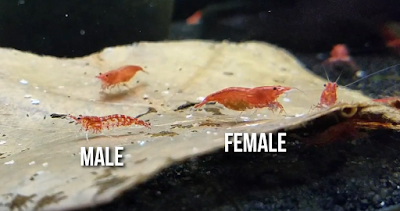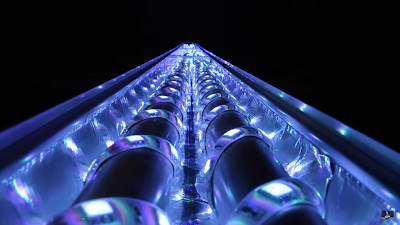If you've been following me on social media, you can tell that I've been bitten by the shrimp breeding bug. Several months ago, I got some high-quality red cherry shrimp from a local breeder, set them up in a 10-gallon tank with everything they could possibly want, and then waited… Hmm, why am I not seeing any babies? Everyone says they’re supposed to breed like freshwater cockroaches. Are my dreams of selling hundreds of shrimp for profit completely doomed?? Luckily, there are lots of helpful veterans in the freshwater shrimp community, and after researching their advice, here’s the troubleshooting checklist I came up with:
#1 Water Quality
I know this seems very obvious, but before we go down the rabbit trail of random reasons why your shrimp may not be breeding, let’s make sure we have all the basics covered. Obviously, we don’t want any toxins in the water, such as ammonia, nitrites, and excess nitrates. Maybe you’re thinking, “I’m fine because they’ve been in well-established, cycled tank for ages.” Well, don’t forget that a population explosion could cause your nitrates to creep up, so remember to bring out that water test kit every once in a while. Also, make sure you don’t have any other toxins coming from outside the tank, such as cigarette smoke, harsh cleaning products being used nearby, or not washing your hands thoroughly before putting them in the tank.As for water parameters, PH is not as important for neocardinas compared to other shrimp species, since they can withstand wide range of 6.0-8.0. Same thing with KH (or carbonate hardness), which can span from 0-8°. However, you should have at least moderately soft to moderately hard water at about 4-14° GH (or general hardness). Also, make sure there’s enough oxygen in the tank. A lot of people like to put shrimp in planted tanks with CO2 injection, so gas levels may be something to watch out for. Certainly, adding a sponge filter or bubbler of some sort will help introduce more oxygen into the water.
#2 Temperature
I wanted to put temperature in its own category because even though cherry shrimp easily live at a wide range of temperatures, they’ll breed more readily at warmer temperatures higher than 72°F (or 22°C). Of course you don’t want to go too far with temperatures hotter than 80°F (or 27°C) because it will shorten the shrimp’s life span and potentially affect the survival rate of eggs and baby shrimp.#3 Stable Environment
When I first got my shrimp, I kept checking every day for berried females, not realizing that newly acquired shrimp have an adjustment period of approximately one to two months where they’re still getting used to their new environment. Once they get comfortable and start breeding, don’t forget it takes another month on top of that for those eggs to hatch.With that in mind, don’t be constantly (or rapidly) changing their environments. In fact, that’s why many veterans recommend not doing frequent water changes or, at the very least, only doing small water changes when you do.
Last comment on their environment is tank size. Obviously, if the aquarium is too small, you may run into overcrowding issues quickly where there's not enough food for everyone or the water quality starts suffering. And some people say that if the tank is too big, then the males can’t locate females in time when the ladies are ready to mate.
#4 Culling
Speaking of males and females, a lot of shrimp keeping veterans recommend a ratio of 1 male to 2 females, or maybe 1 male to 3 females at most because if you don’t have enough males, then they may not be able to catch the female right after she molts. So, point #4 is don’t cull any shrimp while your colony is small. This is actually a mistake I made because I wanted to keep my shrimp as red as possible and unfortunately males don't look very colorful. So if you cull too aggressively too soon, you might accidentally rid yourself of all viable males!#5 Age of Shrimp
Not only do you need to patiently wait while your new shrimp are getting used to their tank, but also because your shrimp might be too young to breed. Sellers often send juveniles that are only 1/2 to 3/4 inches long, and most shrimp reach sexual maturity when they’re closer to an inch (2.1-2.5 cm) long, depending on the gender. So, wait till they get a little bigger before expecting any monkey business.#6 Food and Nutrition
This is a very important criteria, and I fully admit that I've made several of these mistakes. If your shrimp aren’t breeding:- Are you feeding them enough protein? Just like how chicken eggs are full of protein, shrimp also need protein to make their eggs. Consider giving them protein foods (like frozen bloodworms) one to two times a week.
- Are you feeding them enough, period? Everyone always warns beginner breeders not to overfeed their shrimp tank for fear of having water quality problems, but underfeeding will also cause major problems. Shrimp are tiny little grazers that need constant access to food.
- Are they getting enough minerals? I’m going to make a post about the shrimp reproductive process, but females must molt first before they can mate. So, if they don’t have enough calcium and other essential nutrients to successfully molt, you’re not going to get any babies. Personally, my tap water is on the soft side, so I currently use cuttlebone and Shrimp King Mineral food to ensure proper molting.
#7 Predation
There’s a reason why all the experts suggest that you keep a species-only tank for breeding shrimp because almost all fish will prey on shrimp, babies and/or adults. If you’re bent on keeping shrimp with fish, make sure you provide lots of cover with hides or heavy foliage and just be okay with the fact that some babies will get eaten. Also, don’t forget that predation also comes in small packages, such as planaria, hydra, and dragonfly nymphs. Fenbendazole dog dewormer is a popular treatment for planaria and hydra. However, dragonflies are super tough and may require you to restart your tank, since most things that kill them will also kill shrimp. |
| Dragonfly nymph (source: Wikipedia) |
#8 No Babies After Seeing Eggs
Finally, let’s consider the case where maybe your shrimp are successfully mating and carrying fertilized eggs, but you’re not seeing any evidence of babies. First off, baby shrimp are super small and they don’t move a lot for the first few days after birth. So if you had a berried female and suddenly the eggs are gone, it could be that they actually hatched but you’re just not seeing them yet.Another problem may be not having enough biofilm or other baby foods available for the shrimplets. I’ll do a whole post on this later, but I recommend adding Indian almond leaves and cholla wood to grow biofilm, letting lots of algae cover your back and side tank walls, and getting a powdered shrimp food like Bacter AE that will float around the tank so they don’t have to fight the adults to feed.
Also, while you’re doing water changes, make you’re not accidentally sucking them up. I usually move pretty slowly while gravel vacuuming, but just in case, I siphon out the dirty water into a white bucket, use a flashlight to find any escapees, and then return them using a turkey baster.
After a few months of improving my shrimp’s environment and diet, my dreams are finally coming true! I’ve grown from 15 shrimp to a colony of 100 to 200, with more and more babies are popping up every day. Maybe I should start working on my next dream of breeding crystal red shrimp…
Question of the Day
Do you have any tips for breeding cherry shrimp? Comment below to share your experiences because I’d love to hear them. Take time to enjoy your aquariums and I’ll see you next time!Subscribe to my YouTube Channel for practical fish care tips for busy aquarists and follow me on Instagram for more updates! 🎮❤️🐟







